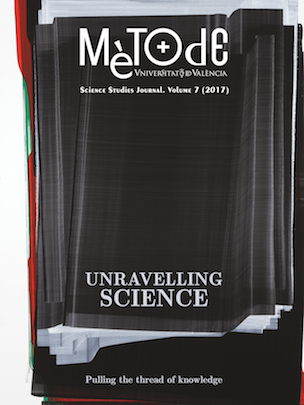Astronomy and space on the big screen: How accurately has cinema portrayed space travel and other astrophysical concepts?
DOI:
https://doi.org/10.7203/metode.7.8530Paraules clau:
astronomy, cinema and science fiction, space travel, asteroids, black holes Resum
Resum
Since its origins, cinema has been fascinated with the subject of scientific developments. In particular, astronomy and astrophysics have played an important role in science fiction stories about space travel and exploration. Though the science has not always been accurately represented, in the last decades there has been more and more interest from the cinema industry in approaching scientists to make sure that the stories and concepts shown in films are closer to our true understanding of the universe. In this article, I will explore how cinema has portrayed astrophysical concepts throughout the decades, and how sometimes cinema has even inspired the direction of scientific research.
 Descàrregues
Descàrregues
 Referències
Referències
Alcubierre, M. (1994). The warp drive: Hyperfast travel within general relativity. Classical Quantum Gravity, 11, L73–L77. doi: 10.1088/0264-9381/11/5/001
Alvarez, L. W., Alvarez W., Asaro, S., & Michel, H. V. (1980). Extraterrestrial cause for the Cretaceous-Tertiary extinction. Science, 208, 1095–1108. doi: 10.1126/science.208.4448.1095
Campbell, B., Walker, G. A. H., & Yang, S. (1988). A search for sub-stellar companions to Solar-type stars. Astronomical Journal, 331, 902–921. doi: 10.1086/166608
Einstein, A., & Rosen, N. (1935). The particle problem in the general theory of relativity. Physical Review, 48, 73–77. doi: 10.1103/PhysRev.48.73
Hawking, S. W. (1974). Black hole explosions. Nature, 248, 30–31. doi: 10.1038/248030a0
Kostov, V. B., Orosz, J. A., Welsh, W. F., Doyle, L. R., Fabrycky, D. C., Haghighipour, N., ... Borucki, W. J. (2016). Kepler-1647b: The largest and longest-period Kepler transiting circumbinary planet. The Astrophysical Journal, 827 (86). doi: 10.3847/0004-637X/827/1/86
Krauss, L. M. (1995). The physics of Star Trek. New York: Basic Books.
Lovell, J., & Kluger, J. (1994). Lost Moon: The perilous voyage of Apollo 13. Boston: Houghton Mifflin.
Moreno Lupiáñez, M., & José Pont, J. (1999). De King Kong a Einstein: La física en la ciencia ficción. Barcelona: Ediciones UPC.
Morris, M. S., & Thorne, K. S. (1988). Wormholes in spacetime and their use for interstellar travel: A tool for teaching general relativity. American Journal of Physics, 56 (5), 395–412. doi: 10.1119/1.15620
Perkowitz, S. (2007). Hollywood science: Movies, science and the end of the world. New York: Columbia University Press.
Sagan, C. (1985). Contact. New York: Simon and Schuster.
Thorne, K. S. (2014). The science of Interstellar. New York: W. W. Norton & Company.
Weir, A. (2014). The Martian. New York: Broadway Books.
Descàrregues
Publicades
Com citar
-
Resum2403
-
PDF 920
Número
Secció
Llicència
![]()
Tots els documents inclosos en OJS són d'accés lliure i propietat dels seus autors.
Els autors que publiquen en aquesta revista estan d'acord amb els següents termes:
- Els autors conserven els drets d'autor i garanteixen a la revista el dret a la primera publicació del treball, llicenciat baix una llicència de Reconeixement-NoComercial-SenseObraDerivada 4.0 Internacional de Creative Commons, que permet a altres compartir el treball amb un reconeixement de l'autoria del treball i citant la publicació inicial en aquesta revista.
- Es permet i s'anima els autors a difondre la versió definitiva dels seus treballs electrònicament a través de pàgines personals i institucionals (repositoris institucionals, pàgines web personals o perfils a xarxes professionals o acadèmiques) una vegada publicat el treball.





